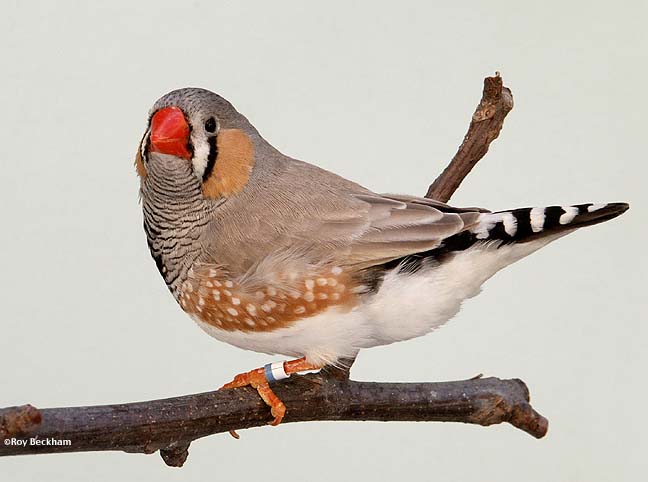




 |
|
|||||||||||||||||||||
 |
|
|
|
|
|
|
|
|
|
|||||||||||||
|
|
|
|
|
|
||||||||||||||||||
|
|
|
|
|
|
|
|
|
|
||||||||||||||
|
|
|
|
|
|
||||||||||||||||||
|
|
|
|
|
|
|
|
|
|
||||||||||||||
|
|
|
|
|
|
||||||||||||||||||
|
|
|
|
|
|
|
 |
|
|||||||||||||||
 |
 |
|
||||||||||||||||||||
|
|
|
|
||||||||||||||||||||
|
|
|
|
|
|
|
|
|
|
|
|
|
|
|
|
|
|
|
|
|
|
|
|
| Lightback Zebra Finch | |||||
 |
|||||
| Lightback Zebra - male | |||||
|
Mutation Effects Male: The head, wings and back are diluted to a silvery gray. The belly and tail coverts are bright white. The cheek patches are diluted to an apricot color and the flanks are diluted to a light orange color. The black markings (tear mark, tail and breast bars) remain at full strength. Female: The gray head, back and wings are diluted as in the male. The belly and tail coverts are also bright white and the tear marks and tail bars remain at full strength. Fledgelings: As soon as the young feather up, the light color of the back can be seen. The beak color is a dark horn color so the young can be distinguished before feathering if mixed in the nest with normals or CFWs. Males split for CFW can be picked out as soon as they feather up as the lighter back color can be seen (see below). Identifying Splits I have not found any reliable way to determine Gray males that are split for Lightback. If comparing birds in the same line or from the same pair that are known to carry Lightback, the males with a cleaner belly may be an indication that the bird is split for Lightback, but this is not terribly reliable. Female: Cannot be split for a sex-linked mutation. Furthermore, females cannot be Lightbacks split for CFW and therefore they cannot match the color of males that are Lightbacks split for CFW.
Combinations The combination with fawn requires a genetic phenomenon known as crossing over to occur before Lightback and Fawn can be combined. Crossing over is a random occurrence so one cannot predict how long, if ever, before the combination will occur. Fawn Lightbacks can be attractive birds, but are not easily distinguished from regular Fawns except for the white belly in both sexes. Once combined the two mutations are linked and will act as one. Luckily, they have already been combined so one need only find a breeder with Fawn Lightbacks to begin producing more. Lightback can be combined with a number of other mutations as well. Some of the more attractive combinations are those that take advantage of the strength of the black markings on a diluted body. Lightback combined with Black Cheek is very attractive as the stark black cheeks on both sexes stand out against the diluted gray on the head. The flanks on the male will often show in undiluted black and these stand out against the pure white belly. Combinations with Black Face work in much the same way as the Black Cheek. Those areas that the BF extended with black will remain at full strength in the combination. The cheek patches and flanks will be diluted. The Black Breasted mutation makes for an attractive combination as well. The extended Breast bar shows in full strength and the extended cheek patches will be diluted ornage. The combination with Orange Breast is also interesting as the breast bar will match the color of the cheek patches. I have not produced or seen the combination, but a multiple combination of Black Breast and Orange Breast with Lightback might be quite beautiful as it would create an apricot colored head and breast on a diluted body. The combination of Lightback and Dominant Silver is also quite beautiful. The body color is diluted even further by the Dominant Silver mutation as well as the cheeks and flanks. The cheeks can achieve a near white color. The black markings will remain at full strength contrasting nicely against the dilute body and white cheeks. It is not clear what effect the other dilute varieties, Recessive Silver, Florida Fancy and Fawn Cheek will have in combination with Lightback, but I can't imagine that the results will be that desireable. Combinations with the pattern mutations (Pied and Penguin) that require some contrast may not benefit from a combination with Lightback. Lightback Black Cheek Fledgling (click to view) Notes |

Lightback female
